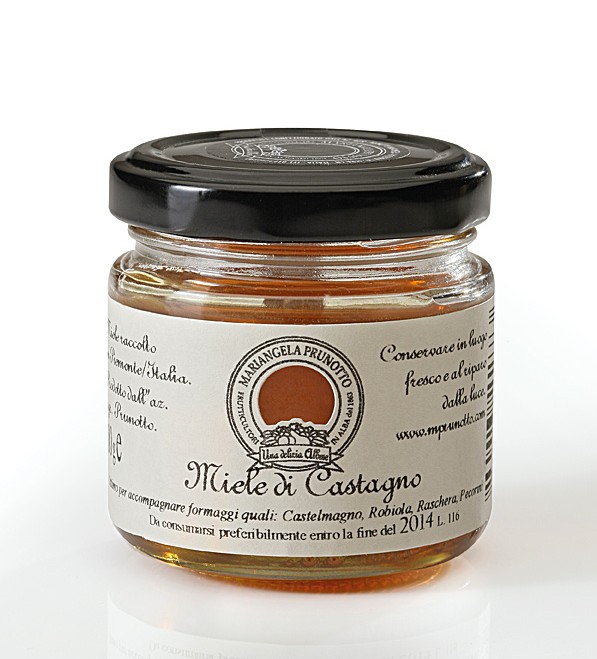 The Chestnut blossom honey is commonly regarded as one of the honeys in particular vocation as an accompaniment to cheese.
The Chestnut blossom honey is commonly regarded as one of the honeys in particular vocation as an accompaniment to cheese.
It is particularly suitable for hard cheeses like Parmigiano Regiano or Pecorino cheese or semi vaccines or medium-aged cheeses.
We follow the flowering of Chestnut (Castanea sativa), particularly in the flourishing and partly in the Langhe and Roero hill, to allow friends to produce this particular honey bees.
Chestnut honey has very specific characteristics and properties. It ‘s dark in color, has a pungent odor and taste very bitter and that is why he is loved by an increasingly larger number of people. Chestnut honey may have a lighter color if the prevalence of nectar, a higher moisture content and odor and flavor more pronounced, and where the honeydew is present in considerable quantity, the color is darker, the lower water content, odor and aroma are less pungent and the taste is less bitter.
The color is dark amber and the crystallization is absent or very slow.
It has a characteristic strong smell of undergrowth. The flavor is intense, with a slightly bitter aftertaste.
Precisely because of this feature is normally paired with cheeses.
Elementary information
Name of the product: Chestnut blossom honey
Category: Honey
Net weight: 100 g or 400 g.
Ingredients: 100% Italian honey from Piemonte
Origin: Piemonte
Period of harvest: June
… a little bit of history ..
To produce honey “Monoflorale” (one flower hoey) we adopt the practice of ‘”Nomad Beekeeping“.
First, it is good to know that the of bees does not fly more than 2 or 3 km radius around the hive.
The nomad beekeeping is a way to move the hives from place to place depending on the presence of plants in bloom. Moreover, these displacements enable the production of flower honeys allowing a better supply of the final product.
One time the hive were loaded onto special boats that went up the rivers towards the most favorable regions from honeydew. When you reached a certain waterline, the hives were full.
Today the movement of hives occur on the road: you load them in the night (when all the bees have returned) and unloaded at sunrise.
The movements are often functional changes in altitude, and the season progresses, beginning from the plains and valleys between April and early June, following the more blooms late July and August, ending with the harvest of honeydew, before return to winter in the plains.
This method, which turns out to have very high costs of management, is in ‘”chase” the various spring flowering and summer moving the combs with the families of bees. This allows us to choose the most healthy and unpolluted places with the greatest concentration of flowers.
… curiosity …
The most ancient depiction of honey collection it has been discovered in 1921 on the walls of the cave spider in spain, dates back to the Neolithic period around 5000 BC.
A family of bees consists of one queen bee, many (from 6,000 to 70,000) workers (sterile females), from drones (males) and brood (larvae). A hive consists of a single colony or family.
The bees are on earth from 4 million years for the same current appearance.
Worker bees have an average life of 6 weeks in summer and are primarily responsible for supplying the hive with their favorite food, while those born in late summer or early autumn will live from 5 to 6 months will have a body more rich in fat acids. Their work is to protect the queen, to keep the swarm in glomere that will pass the winter at a temperature of about 30 ° C, and then, in February, prepare for the arrival of new generations.
In ancient Babylon, the just married couples received as a symbol of fertility, honey in a quantity sufficient for one month. (hence, perhaps, the honeymoon period).
To produce 1 kg of honey are needed more than 50,000 flights round trip from ‘hive to flowers, for a total of 150,000 km, flown to haul flowers that grow to a radius of 3 km from the hive.


